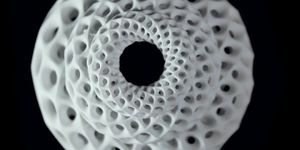
The majority of antibiotics prescribed today were created by screening soil microorganisms-a finite source that was tapped out decades ago, and not readily replaced with suitable synthetic alternatives. Drug-resistant pathogens are an elusive culprit, outpacing our ability to eradicate them.
A new approach may be at hand.
Kim Lewis, PhD, university distinguished professor and director, Antimicrobial Discovery Center, Northeastern University, College of Science, Boston, and his colleagues have found a new antibiotic-called teixobactin-which vanquishes pathogens with no resistance.
"Our impression is that nature produced a compound that evolved to be free of resistance," says Lewis. "This challenges the dogma that we've operated under that bacteria will always develop resistance. Well, maybe not in this case."
Uncultured bacteria comprise about 99 percent of all species in external environments, and are a fresh wellspring for new antibiotics. The researchers formulated ways to grow uncultured organisms in their natural environment. The paper discusses teixobactin, which was detected in a screen of uncultured bacteria.
This discovery could be the answer for treating patients who have multidrug-resistant tuberculosis (MDR-TB) and Methicillin-Resistant Staphylococcus aureus (MRSA) Infections.
The researchers note that teixobactin inhibits cell wall synthesis by binding to a highly conserved motif of lipid II and lipid III. They did not find mutants of S. aureus or Mycobacterium tuberculosis resistant to teixobactin.
Lewis and Northeastern biology professor Slava Epstein, PhD, an expert in microbial ecology, diversity, and biotechnology, co-authored the paper with colleagues from the University of Bonn, Germany, NovoBiotic Pharmaceuticals, Cambridge, Mass, a biotech company, and Selcia Limited, UK, a contract research firm.
The findings, recently published in the journal Nature in an article titled "A new antibiotic kills pathogens without detectable resistance," are found here: bit.ly/1Iw24mE
Lewis' expertise is in molecular microbiology. The Lewis Lab analyzes persister cells responsible for biofilm tolerance to antibiotics and uncultured bacteria of the environment and the microbiome, and his team was instrumental in studying and testing the compound's resistance from pathogens.
NovoBiotic (an outgrowth of these efforts) has now assembled some 50,000 strains of uncultured bacteria and discovered 25 new antibiotics. Teixobactin, which the researchers hope to develop into a drug, is the latest and most interesting, Lewis says.
"(The researchers') work offers hope that innovation and creativity can combine to solve the antibiotics crisis," Wright notes in the paper.
Image: S aureus
This digitally-colorized scanning electron micrograph (SEM) depicts four magenta-colored, spherical methicillin-resistant Staphylococcus aureus (MRSA) bacteria that were in the process of being phagocytized by a blue-colored human white blood cells (WBCs) known specifically as a neutrophil. [Photo credit: National Institute of Allergy and Infectious Diseases (NIAID)]
 The majority of antibiotics prescribed today were created by screening soil microorganisms-a finite source that was tapped out decades ago, and not readily replaced with suitable synthetic alternatives. Drug-resistant pathogens are an elusive culprit, outpacing our ability to eradicate them.
The majority of antibiotics prescribed today were created by screening soil microorganisms-a finite source that was tapped out decades ago, and not readily replaced with suitable synthetic alternatives. Drug-resistant pathogens are an elusive culprit, outpacing our ability to eradicate them.







